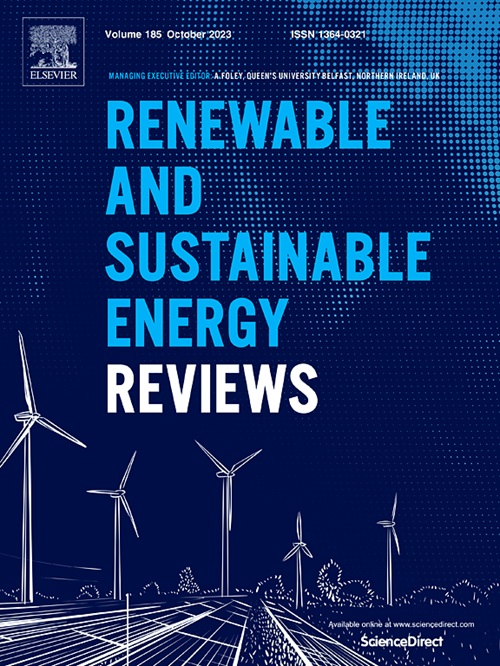Strategies and challenges for reducing green hydrogen cost: Operation mode and revenue streams
IF 16.3
1区 工程技术
Q1 ENERGY & FUELS
引用次数: 0
Abstract
The high cost of green hydrogen prevents the introduction of low-carbon hydrogen into the economy. This work aims to improve the profitability of water electrolysis by providing a holistic analysis of PEM electrolysis in steady and dynamic operation modes. In addition, additional streams of revenue are discussed, including the selling of waste heat from electrolysis and participating in electricity reserve markets. First, a data-driven model was developed to simulate the efficiency of PEM electrolysis as a function of loading percentage. Afterwards, the levelized cost of hydrogen (LCOH) was calculated in steady and dynamic operation modes. The sensitivity to capital cost assumptions, electrolyzer degradation rates, the efficiency profile of AC/DC rectifier, and the electricity profile was studied. It was found that dynamic operation affects the LCOH when compared with steady operation under identical electricity price profiles, ranging from decreasing the LCOH by 42 % to increasing the LCOH by 7.6 %. Moreover, each 1 µV/h increase in the electrolyzer degradation rate increases the LCOH by about 1.3–2.2 %. Conversely, utilizing electrolysis waste heat reduces the LCOH by 0.2–0.35 EUR/kg. Finally, the revenue from participating in electricity reserve markets could range from exceeding the total cost of green hydrogen production to not offsetting the increase in capital costs that result from a lower capacity factor. Overall, a holistic optimization of dynamic electrolysis operation is crucial to ensure that the reduction of LCOH from extra streams of revenue and lower electricity prices exceeds the increase in LCOH from a higher degradation rate and lower capacity factor.
降低绿色氢成本的策略与挑战:运营模式与收益流
绿色氢的高成本阻碍了将低碳氢引入经济。本工作旨在通过对PEM电解在稳定和动态运行模式下的整体分析,提高水电解的盈利能力。此外,还讨论了其他收入来源,包括出售电解废热和参与电力储备市场。首先,建立了一个数据驱动模型来模拟PEM电解效率作为负载百分比的函数。然后,计算了稳态和动态运行模式下的氢气平准化成本(LCOH)。研究了对资本成本假设、电解槽降解率、交直流整流器效率分布和电力分布的敏感性。结果表明,与稳定运行相比,在相同电价情况下,动态运行对LCOH的影响从LCOH降低42. %到LCOH提高7. %不等。此外,电解槽降解速率每提高1 μ V/h, LCOH可提高约1.3-2.2 %。相反,利用电解废热可使LCOH降低0.2-0.35欧元/千克。最后,参与电力储备市场的收入可能超过绿色制氢的总成本,也可能无法抵消因容量系数降低而导致的资本成本增加。总体而言,动态电解操作的整体优化对于确保额外收入流和较低电价带来的LCOH减少超过较高降解率和较低容量系数带来的LCOH增加至关重要。
本文章由计算机程序翻译,如有差异,请以英文原文为准。
求助全文
约1分钟内获得全文
求助全文
来源期刊

Renewable and Sustainable Energy Reviews
工程技术-能源与燃料
CiteScore
31.20
自引率
5.70%
发文量
1055
审稿时长
62 days
期刊介绍:
The mission of Renewable and Sustainable Energy Reviews is to disseminate the most compelling and pertinent critical insights in renewable and sustainable energy, fostering collaboration among the research community, private sector, and policy and decision makers. The journal aims to exchange challenges, solutions, innovative concepts, and technologies, contributing to sustainable development, the transition to a low-carbon future, and the attainment of emissions targets outlined by the United Nations Framework Convention on Climate Change.
Renewable and Sustainable Energy Reviews publishes a diverse range of content, including review papers, original research, case studies, and analyses of new technologies, all featuring a substantial review component such as critique, comparison, or analysis. Introducing a distinctive paper type, Expert Insights, the journal presents commissioned mini-reviews authored by field leaders, addressing topics of significant interest. Case studies undergo consideration only if they showcase the work's applicability to other regions or contribute valuable insights to the broader field of renewable and sustainable energy. Notably, a bibliographic or literature review lacking critical analysis is deemed unsuitable for publication.
 求助内容:
求助内容: 应助结果提醒方式:
应助结果提醒方式:


